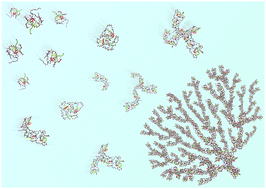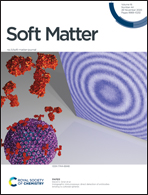A spectroscopic and molecular dynamics study on the aggregation process of a long-acting lipidated therapeutic peptide: the case of semaglutide†
Abstract
The aggregation properties of semaglutide, a lipidated peptide drug agonist of the Glucagon-like peptide 1 receptor recently approved for the treatment of type 2 diabetes, have been investigated by spectroscopic techniques (UV-Vis absorption, steady-state and time-resolved fluorescence, and electronic circular dichroism) and molecular dynamics simulations. We show that in the micromolar concentration region, in aqueous solution, semaglutide is present as monomeric and dimeric species, with a characteristic monomer-to-dimer transition occurring at around 20 μM. The lipid chain stabilizes a globular morphology of the monomer and dimer species, giving rise to a locally well-defined polar outer surface where the lipid and peptide portions are packed to each other. At very long times, these peptide clusters nucleate the growth of larger aggregates characterized by blue luminescence and a β-sheet arrangement of the peptide chains. The understanding of the oligomerization and aggregation potential of peptide candidates is key for the development of long acting and stable drugs.

- This article is part of the themed collection: Peptide Soft Materials


 Please wait while we load your content...
Please wait while we load your content...